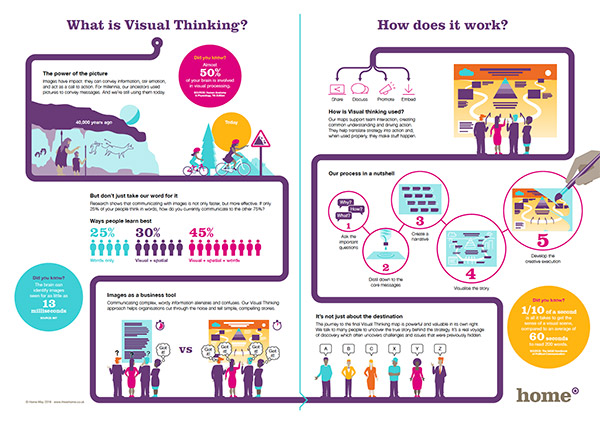We believe Visual Thinking is an amazing tool to help businesses communicate complex stories. A few of our clients asked how the process actually works – so I thought I’d share some secrets…
In my last post I talked about the power of images in business communication. Not a lot of people know this, but a few years ago I took time out from Home to really dive into images as a communication tool. I studied, drew, tested and learned – and Visual Thinking emerged. Much more than an infographic, our Visual Thinking maps help you distil a message to its simplest form, so others can develop a shared understanding. It weaves imagery and narrative together to create a roadmap to success which can be easily understood and shared.
It’s not just about the destination
When we started Visual Thinking, the thing that surprised me most was how powerful and valuable the process itself is. The journey to the final Visual Thinking map goes deep. We talk to a lot of people to uncover the true story behind the strategy. It’s a real voyage of discovery which often uncovers challenges and issues that were previously hidden from view.
But let’s keep it simple
That said, the process itself is very simple:
- We ask what, why and how.
- Then we work with the client to decide what’s most important and – crucially – what needs to happen (Visual Thinking usually drives change).
- We create a structure.
- At this point things are usually quite wordy so we strip back again and again until we reach the core points.
- Then we develop our creative themes to bring everything together… but that’s a story for another day.
The whole process helps leaders grapple with the big questions to create clear, resonant answers, which usually leading to new discoveries about the organisation.
How is Visual Thinking used?

Our maps (stunning though they are!) are definitely not designed to be hung on the wall. They need to be used. They support team interaction, creating common understanding and driving action. Visual Thinking creates a consistent cascade of information that helps employees answer the big questions, in the same way leaders did during the discovery phase. It helps translate strategy into action. Used properly, Visual Thinking makes stuff happen.
Why not download our handy PDF guide as a visual thinking reference point…
Getting visual with it
Feeling inspired? Why not grab a pen and see what a spot of Visual Thinking can do for you? Drawing was one of the first ways you made sense of the world, so why not think visually to solve your current challenges? At the very least, you’ll get a fresh point of view…





 Back to all
Back to all



